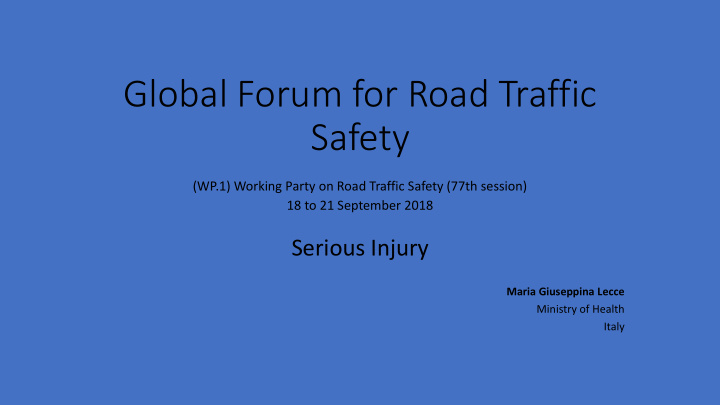



Global Forum for Road Traffic Safety (WP.1) Working Party on Road Traffic Safety (77th session) 18 to 21 September 2018 Serious Injury Maria Giuseppina Lecce Ministry of Health Italy
BACKGROUND • Road safety performance has traditionally been measured almost entirely by the reduction of fatalities. • Serious but non-fatal accidents also present a major health problem with huge economic and human costs to society.
3 steps In 2010, the Council responded to the Commission’s policy orientations paper by : • underlining the urgent need to address serious injuries • supporting the development of a common definition • agreeing to the principle of a specific quantitative target
European Parl rliament resolution of f 27 September 2011: : European road safety 2011-2020 The European Parliament in 2011 expressed its support for • initiatives on serious injuries, • calling for a target of 40% reduction in the number of persons seriously injured on roads, • calling on the Commission to establish a common definition of seriously injured in road traffic accidents
Common definition In road safety data, the severity of an injury was sometimes defined: • on the basis of medical classifications , • sometimes in terms of the long-term effects of the injury. • by the length of hospitalization needed. However, different Member States applied different practices. data were not comparable
Different practices UK Hospitalised or according to national definition GR Police records; presumed >=24h in hospital HU Injuries needing hospital care or >8 days to heal LU >=24 hours in hospital DE >=24h in hospital IT Not defined CZ As decided by medical doctor or >=24h hospital
Further problems stem from misreporting and underreporting .
The most common process for data collection has been that road accident data are reported from the place of the accident, by the police or other law enforcement authorities.
Member States might choose to proceed three main ways: • continue to use the police data but apply a correction coefficient; • report the number of injured based on data from hospitals ; • create a link between police and hospital data .
The common definition of serious injury needs to be based on an already established medically classified standard . This would avoid arbitrary diagnoses , and not put any extra administrative burden on medical staff, and has the added advantage of being internationally comparable .
MAIS The already existing trauma scale ‘Maximum Abbreviated Injury Score’ (MAIS) was seen as the preferable option for a common definition .
MAIS The MAIS is a globally accepted trauma scale used by medical professionals. It provides an objective and reliable basis for data collection. The injury score is determined at the hospital with the help of a detailed classification key. The score ranges from 1 to 6 , with levels 3 to 6 considered as serious injuries.
The benefit of using this specific classification system is that it has high validity and reliability. The use of a detailed classification key reduces the risk of arbitrary diagnosis and also the risk of misreporting would be substantially reduced. Moreover, it is also internationally comparable .
Algorithms for conversion • ensure correct assessment of injury severity . • Gathering these data should not require the development of new structures or processes as the information normally already exists in hospital data bases. • Algorithms for conversion exist for cases where the hospital reports use other codes than the MAIS.
Italy
Algorithms for conversion
Further step: record linkage the use of hospital records will not provide all of the data on causes and characteristics of accidents that can be delivered by police reports. • The relevant data from hospital records would need to be processed into road traffic databases in anonymised form to prevent sensitive or private health-related data from being improperly handled.
Thanks for your attention m.lecce@sanita.it
Recommend
More recommend